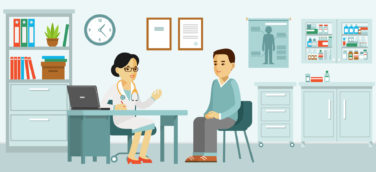Data collection, and interconnected devices and platforms, are helping patients throughout their journey every day. Companies from all facets of health are involved…and pharma isn’t being left behind.
The global market for Internet of Things is estimated to be above $151 billion, and worldwide IOT tech spending is expected to reach $1.2 trillion by 2022. The healthcare sector—the Internet of Medical Things, or IoMT—is expected to be the No. 3 industry in this push, behind only the consumer sector and insurance. IoMT alone is expected to be worth more than $158 billion by 2022.
IoMT solutions can help everyone in the entire healthcare system in myriad ways—from helping nurses get patients’ vital signs more easily and accurately; to giving caregivers peace of mind about their loved ones; to shedding light on new active compounds for clinical researchers. Or, of course, helping pharma and life sciences companies to help patients, getting the right medications to the right people more effectively and efficiently.
The possibilities of what IoMT tools can do runs the gamut and is limited literally only by our own creativity. They can be extremely complex or elegantly simple. They can require FDA approval or not. They can involve patients directly, or they can impact the patient journey without a patient ever encountering one personally. An incomplete list of current solutions could include: Devices worn on a patient’s body; monitoring tools in patients’ homes; solutions to improve processes (which could include diagnosis, prescribing, or treatment) in professional settings such as hospitals, HCP offices, or ambulances; or devices to help with the logistics of pharmaceuticals from manufacturing to shipping to inventory administration.
Wherever they exist, the connectivity of these devices is their inherent benefit. It allows knowledge to be shared more than ever before. It’s impossible to list all of the tools currently available—which is a wonderful problem to have—but it is possible to investigate how pharma is helping patients using IoMT solutions, at the pharmacy and throughout the patient journey.
Current efforts might be categorized in one of two ways:
- First, by using connected devices to improve existing paradigms; or
- Second, by using connected devices to create entirely new paradigms.
Improvements: Tech Twists on Pharma’s Pharmacy Standbys
Offering coupons for medications is a time-tested part of receiving medication, at least in the United States. A mainstay of many pharmaceutical company’s marketing strategies, coupons can be the incentive that helps a patient to try a new treatment, or to remain adherent despite the vagaries of insurance coverage.
The idea of keeping medical records for patients is quite a bit older. The oldest patient records date back to ancient Mesopotamia, thousands of years ago. But today, thanks to the modernization of the latter, a modernization of the former is possible. It’s now possible to embed opportunities for HCPs to offer patients support programs, coupons, or vouchers, through their electronic health records (EHR). This way, as soon as a prescriber writes a script, they have the ability to immediately offer the patient these additional supports.
These programs can be particularly useful in cases of specialty drugs, whose prescription can require additional paperwork that once needed to be filled out manually and faxed. With enrollment forms that can be completed digitally inside an EHR, patients can get medication without delay, the workload of office staff is reduced, and future information—coupons, educational information, or other communication—can be sent more easily to the patient and their provider.
Innovations: Creativity and Collaboration
While some IoMT tools are ways to improve the efficiency and effectiveness of existing processes, others seem much more like something out of science fiction. It’s not too hard to imagine a futuristic movie—form-fitting jumpsuits, telepathy, jetpacks—in which someone swallows a pill that immediately goes to work communicating as it takes effect.
But collaborations between drugmakers and tech players are already making headlines for creating tools like that in real life. Otsuka Pharmaceuticals and Proteus Digital Health’s digital ingestion tracking system, Abilify MyCite, has been called the first digital medication, and has a sensor embedded into the medication tablet.
As the American Council on Science and Health explains it, “The sensor, made up of copper, magnesium, and silicon, functions like a battery by releasing an electronic signal when it has reached the acid in your stomach. The signal sends information about the date and time you took the pill, blood pressure, temperature, and level of activity to an adhesive patch worn on the skin. The patch relays this data to your smartphone app, into which users can add their self-reported mental health data about how they are feeling. Users consent to allow their doctor and up to four other caretakers to view their digital pill data, which resides in a cloud-based system.”
Medication administration is a field ripe for IoMT enhancement. Smart inhalers, like Teva’s ProAir Digihaler, track medication use and the patient’s ability to inhale in an app whose data can be shared with their HCP. Similarly, connected injectables—Companion Medical’s was the first FDA-approved “smart insulin pen”—can at least store dosage data, if not add in environmental information, and provide analytic and sharing capabilities too.
Other Areas of Opportunity
The examples above focus on pharmacy-related ways that healthcare can be improved for patients using connected-device platforms. But, as noted, the total opportunities are nearly endless.
As with any field, the areas of greatest opportunity are the places in the system that are most costly or inefficient. In healthcare, areas of opportunity are ones with the greatest opportunity to save and change lives.
Leading causes of death like heart disease and cancer can be fought with tools that help to improve general health and well-being. Chronic diseases can be helped by better monitoring that infers more accurate predictions. Rare diseases can be helped by tools that improve the likelihood of an early and accurate diagnosis. The health of developing countries can be improved by the creation of solutions that work in technology that’s portable, common, and inexpensive. Medical science worldwide can be improved by tech that makes it possible to bring drugs to market faster that help more patients.
As data stores get ever larger—estimates are that, by next year, 1.7MB of data will be created every second for every person on earth—algorithms are able to learn more, the predictive capabilities of our IoMT tools will increase. Rather than only being able to report on what a patient’s symptoms had been, we’ll become ever more accustomed to getting predictions of what’s likely to happen.
Conclusion
Digital technology is enabling pharma to become more patient-centric. This is because digital technology is helping the world to become more individualized. The adaptability that digital tech allows means that we no longer need to answer a problem with only one answer. All too often, one-size-fits-all fits nobody. Today, not only can we adjust digital tools so that they can provide personalized information, but we can use the data that they provide to understand the problem better and better.
Pharma-driven connected-device platforms have the potential to change, improve, and even save many lives. As with any innovation in our industry, it won’t come easy, because the space is so highly regulated, but the drive toward improved patient outcomes means that progress will, if slowly, evolve. We’ll navigate guidelines and regulations from industry, academia, government and others in order to bring safe, effective tools to patients, providers, payers, and caregivers. We’ll manage compliance, privacy, consumer sentiment, and other challenges along the way.
Understand the Tools, the Hype, and the Hope
It’s important, however, to remain skeptical and questioning. Hype can be a dangerous thing, particularly when the promise of saving lives can bring such hope. To create real answers, we need to approach problems with the right strategy, the right information—and the right people. Today’s pharma innovators need to be a very specific type of people—those who are well-versed and knowledgeable in the science and process of pharmaceuticals, but hybrid with tech wisdom and savvy. The biggest failures of technology implementation result from having an imbalance—either digital experts without practical understanding, or experts in the business who don’t fully understand the tools they want to use.
But there’s great reason for optimism. Adjacent technologies support and promote each other, and as we’ve discussed, the increasing capabilities of software to parse and predict, and of hardware to do ever more with ever smaller objects, go hand in hand. As regulations around the digitization and interoperability of data systems evolve, systems will be able to increase their sophistication and scale accordingly.
Connected-device platforms, once the realm of science fiction, are now commonplace. As you read this, you probably have at least one within arm’s length. Using these tools and technologies to help patients throughout their journeys is a goal of many within pharma, and—like our devices themselves—is within reach.









